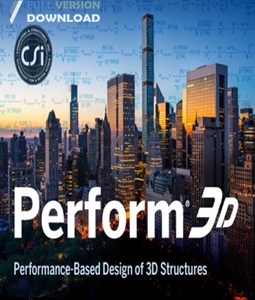CSI Perform3D 8 – CSI Make special 3D programs with a special focus on earthquake proof design. With this program, complex structures, including structures with shear walls, can be analyzed non-linearly on the basis of various strength and strain limit states.
The geometry of the model can be read from the SAP2000 or ETABS program. Various types of elements can be used in the program, including: beams, struts, wall panels (with an opening), floor slabs, gates and partitions. Nonlinear analyzes can be performed statically or dynamically on a model. Loads can be applied to the structure in different stages. For example, the dynamic load of an earthquake can be applied after a non-linear static load. It has powerful performance-based design features and can calculate the necessary capacity ratios for all components and for limit states. Performance evaluations based on ATC40, FEMA356, and ATC440 are automated.
Perform3D is a structural design software useful for evaluating the performance of structural systems. State-of-the-art constitutive modeling capabilities enable the characterization of material non-linearities, including strength and stiffness degradation during hysteresis at the component level. The analysis functions also extend to geometric non-linearity and the effects related to the behavior of PDelta.
Advanced modeling tools allow sophisticated simulation of structural behavior. Components can be grouped according to type, position, and limit state before evaluation is carried out against the required capacity indicator based on strength or strain. Dynamic visualization of DC usage is available through color-coordinated time course animations.
Here are some key features of “CSI Perform3D 8.0.0 Build 1134”:
- Reading the geometry of the SAP 2000 and ETABS model
- Modelability with any number of elements
- Linear and non-linear elements
- Simple handling of the graphical program environment
- Beam, column and bracing elements
- Shear zone and plate
- Shear walls complexes with opening
- Gasket break
- Floor plate
- Liquid damper
- Friction separator
- Plastic gaskets with PMM interaction
- PDelta effects
System Requirement
- Processor
– Minimum: Intel Pentium 4 or AMD Athlon 64
– Recommended: Intel i5/i7, AMD Athlon X4/Ryzen, or better
– A 64-bit CPU is required
– The SAPFire Analytical Engine includes multi-threaded solvers and algorithms that can take advantage of multi-core CPUs. The design algorithms can also utilize multiple cores. - Operating System
– Microsoft Windows 8.1 or Microsoft Windows 10
– 64-bit processor - Video Card
– Minimum: Supporting 1024 by 768 resolution and 16 bits colors for standard (GDI+) graphics mode
– Recommended: Discrete video card with NVIDIA GPU or equivalent and dedicated graphics RAM (512 Mb or larger) for DirectX graphics mode. The card must be DirectX 11 Compatible.
– DirectX graphics mode fully utilizes the hardware acceleration provided by a GPU and dedicated graphics RAM.
– For better graphics quality in terms of anti-aliasing and line thickness, the device raster drawing capabilities should support legacy depth bias. - Memory
– Minimum: 8 GB RAM
– The problem size that can be solved and the speeds for solution & response recovery increase considerably with more RAM. - Disk Space
– 6 GB to install the software.
– Additional space will be required for running and storing model files and analysis results, dependent upon the size of the models
– Recommended: 500GB or larger PCIe Solid State Drive (SSD). External and network drives are not recommended.
Download CSI Perform3D 8.0.0 Build 1134


